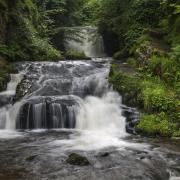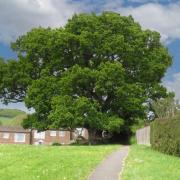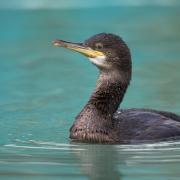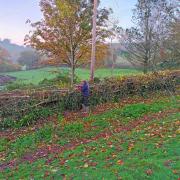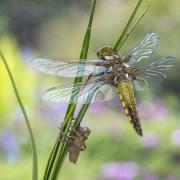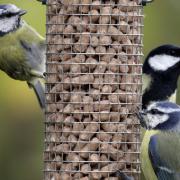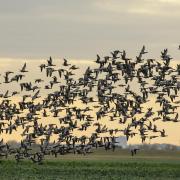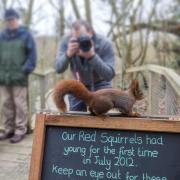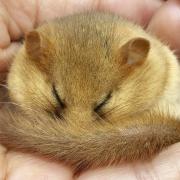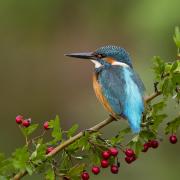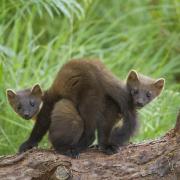Stephen Hussey goes in search of Devon's biggest beast at Rackenford and Knowstone Moors Nature Reserve near Tiverton
Stephen Hussey goes in search of Devon’s biggest beast at Rackenford and Knowstone Moors Nature Reserve near Tiverton
The Devon Wildlife Trust nature reserve which encompasses both Rackenford Moor and Knowstone Moor is big. Big in a literal sense, its 120 hectares make it one of DWT’s largest nature reserves. But this place is big in other ways too. Its mix of grassland, heathland and bog lend this landscape a grand scale. There are few trees to obstruct the eye in any direction. This means wonderful views over a huge swathe of Devon’s interior, reaching Exmoor to the north and Dartmoor to the south. The nature reserve also receives some big weather, with wild winds and more than its fair share of rain. But on a sharp winter’s morning, against the backdrop of a vast blue sky, with frost-crystallized outlines on every clump of purple grass, heather and gorse, Rackenford and Knowstone Moor Nature Reserve is a wonderful place to be. It is a shame that the A361 Devon Link Road cuts through the nature reserve, pushing people north and south without causing them to pause. For those that do stop, Knowstone and Rackenford Moors provide good walking and wildlife-watching opportunities. The Two Moors Way crosses the nature reserve bringing a steady trickle of walkers, but stray from this path and you should have the place to yourself, apart from the wildlife.These moors are home to Devon’s largest land mammal – the red deer – and October is the time to catch the ‘rut’. This is the period in which red deer society loses its normal calm and enters a state of unrest. Dominant stags spend their time guarding groups of hinds (females), bellowing out warnings to potential rivals and occasionally coming to blows with them. These stags cut imposing figures with their antlers, shaggy manes and muscle bulk. Regular wallowing in mud mixed with their urine and faeces provides a further visual and scented statement of virility.Outside of the few feverish weeks of the rut peace descends over red deer society as stags and hinds divide into their own herds. The deer also become less adventurous and are less likely to be seen for long periods on open ground. But whenever you choose to visit this beautiful part of Devon there should be lots of wildlife to enjoy. Rackenford and Knowstone Moors possess an impressive bird list which includes curlew, snipe, nightjar, whinchat and hen harrier. While its butterflies and moths include two rarities – the marsh fritillary and the narrow-bordered bee hawkmoth. Even for the unluckiest visitor, the person for whom wildlife scatters at the first sound of their footsteps, there’s still the simple pleasures brought by a walk through the moors’ vast landscape. A sense of space and the feeling of freedom often seem like scarce commodities in our modern world, but at Rackenford and Knowstone Moors Nature Reserve they can be had in abundance.
The red deer rutAutumn is the best time to see red deer. This is the rut or mating season, a period when the animals are often active during daytime. The deer, which have spent the summer and early autumn enjoying the year’s best and most plentiful feeding, are also in tip-top condition. Their coats are lush, while the stags’ antlers are full grown and devoid of the velvet covering that envelops them as they develop.The behaviour of red deer is also at its most spectacular. In September, herds of red deer stags begin to fracture as the males go in search of hinds. When stags are established in hind herds the real action begins, with males battling for dominance and driving out rivals. It is the largest stags in their prime – between six and twelve years of age – that usually come to dominate. Big antlers matter too but a large-bodied stag with comparatively small antlers will normally succeed over a smaller stag with larger antlers.In October and early November red deer society is in a state of restlessness as dominant stags spend their time mating and guarding their hinds. Dominant males cut imposing figures. Posturing displays of power, accompanied by bellowing, are often enough to deter rivals, but physical confrontations do happen. Fights can last up to 30 minutes, with each animal lunging and using their antlers to push the other back. Serious injury or death is rare – the multi-pointed antlers act to lock combatants together, making battles more sumo than sword fight.By the end of the rut the constant state of readiness demanded of dominant stags weakens them. With little time for feeding, stags will have lost as much as 15% of their bodyweight. This means that some will succumb to starvation or disease in the winter months that follow. However, their prize is ensuring their own genetic inheritance. The next generation of red deer calves are born in May and June.
Where to watch red deer this monthIt’s possible to see red deer almost anywhere in north Devon and Somerset. However, significant herds are concentrated upon Exmoor and its southern hinterlands to Tiverton and South Molton. The following are especially good places:• DWT’s Rackenford and Knowstone Moors Nature Reserve (nine miles north of Tiverton on the A361. Use OS Explorer map 114, grid reference SS 836219 or postcode EX36 4DY to locate the nature reserve’s Knowstone Inner Moor entrance. For detailed directions and more visitor information go to www.devonwildlifetrust.org/reserve/;• Witheridge Moor (north of the B3137 between Tiverton and Witheridge);• On Exmoor: National Trust moorland around Dunkery Beacon; National Trust’s Horner Wood; Porlock Common; between Withypool and Winsford, and south to Winsford Hill and The Punchbowl; Dane’s Brook to the south of Hawkridge.
Dawn and dusk give the best chances of seeing red deer. Remember to observe local access conditions at the sites listed above.
New bookThis article was based on a chapter in Devon Wildlife Trust’s Nature Reserves – a new book which features 20 of the best wildlife watching places in the county. Fully illustrated with wonderful photography, and using 100 previously unpublished wildlife photos, the book gives a guide to the character and wildlife of many of Devon’s most beautiful nature reserves. The book is available exclusively to members of Devon Wildlife Trust. To become a member and receive your copy call 01392 260832 or visit http://www.devonwildlifetrust.org/



